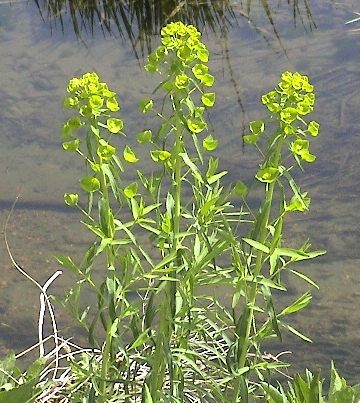Leafy Spurge (Euphorbia esula L.)
Identification
 Leafy spurge is of European origin. It is considered a noxious weed and is included on the Colorado and Adams County Noxious Weed Lists. It is probably the most serious noxious weed threat in Colorado. This deep-rooted perennial forb spreads by seed and by aggressive, creeping horizontal roots (rhizomes). Vertical roots can extend as deep as 30 feet, are brown in color, and contain numerous pink buds that generally produce new shoots or roots. It is because of this root system that leafy spurge is extremely difficult to control. The shoots grow from 1 to 3 feet tall, are pale green and unbranched except for flower clusters.
Leafy spurge is of European origin. It is considered a noxious weed and is included on the Colorado and Adams County Noxious Weed Lists. It is probably the most serious noxious weed threat in Colorado. This deep-rooted perennial forb spreads by seed and by aggressive, creeping horizontal roots (rhizomes). Vertical roots can extend as deep as 30 feet, are brown in color, and contain numerous pink buds that generally produce new shoots or roots. It is because of this root system that leafy spurge is extremely difficult to control. The shoots grow from 1 to 3 feet tall, are pale green and unbranched except for flower clusters.
Leaves are alternate, narrow, linear, ¼ inch wide, and 1 to 4 inches long. Stems are thickly clustered. Flowers are very small and yellowish-green. They are enclosed by very visible yellowish-green, heart-shaped bracts. The stems contain a milky sap that is damaging to eyes and sensitive skin, and causes severe irritation of the mouth and digestive tract in cattle.
Leafy spurge will grow on good cultivated lands, shallow rocky soils, rangelands, and along waterways. Where it becomes established, it crowds out practically all other vegetation. Although it is unpalatable to cattle, sheep and goats eat spurge, and are useful biocontrol tools in an integrated weed management program.
In Adams County, leafy spurge can mainly be found along the South Platte River and along Kiowa Creek. If you think you might have this weed on your property, or would like more information, please contact the Adams County Weed Department at 303-637-8115
Cultural Management
Seeding and Maintaining selective perennial grasses can be an effective tool. Early emerging grasses that utilize early season moisture have reduced spurge density and limited the spread and establishment of new infestations. Sequential glyphosate (e.g. Roundup) applications followed by a seeding of Luna pubescent wheatgrass, Ephraim crested wheatgrass, intermediate wheatgrass, Sherman big bluegrass, or Bozoisky Russian wild rye, has shown to be effective in reducing an infestation of spurge in Wyoming. Proper grazing management and eradication of small spurge infestations are always desirable cultural tools.
More complete information on grasses can be found on the Grass Seeding on the Eastern Front-Range of Colorado page or by contacting the Natural Resources Conservation Service.
Mechanical Management
 Mechanical control of spurge is difficult because it is a creeping perennial. However, multiple stresses applied to plants are very effective. Frequent mowings through summer reduces the herbicide application rate needed in the fall. Mowing spurge a regular intervals 4 to 6 times per spring/summer is an effective stress treatment that will reduce root food reserves and prevent seed set. Mow as plants regrow and before flowering stage. Spurge’s milky sap has been known to gum up mowers.
Mechanical control of spurge is difficult because it is a creeping perennial. However, multiple stresses applied to plants are very effective. Frequent mowings through summer reduces the herbicide application rate needed in the fall. Mowing spurge a regular intervals 4 to 6 times per spring/summer is an effective stress treatment that will reduce root food reserves and prevent seed set. Mow as plants regrow and before flowering stage. Spurge’s milky sap has been known to gum up mowers.
Cultivation can be done at two to four week intervals, but is costly and can bare soil to erosive factors. Research results are not available that indicate whether stand reduction or eradication can occur from the sole use of mechanical treatments.
Biological Management
Both sheep and goats have been found to be effective grazers of spurge. (The milky sap of this weed is incurious to cattle and horse mouths.) Grazing sheep can commence after spring regrowth reaches two to six inches tall, but before the flowering bract stage. Goats can graze spurge at any time. Grazing can proceed to mid August or so. Do not overgraze. If animals are turned into a site after the spurge has set seed, quarantine animals in a corral for seven days before releasing them into a non-infested pasture. Sheep may need a breaking in period of two weeks before they readily eat spurge.
Several insect species have been released by the USDA/APHIS that affect spurge. Of the flea beetles three species have been found to be most effective. Apthona nigriscutis, Apthona lacertosa, & Apthona flava have been found to be effective after three years on large infestations. Contact the Adams County Weed Department or your local extension office for details on these flea beetles.
Herbicide Management
Herbicides that have been effective when used independently or in some combinations are: picloram (Tordon), dicamba (Banvel), 2,4-D (aquatic formulations) Glyphosate, imidazol and fosamine are suitable for use on riparian sites. Picloram and dicamba can injure or kill trees. If a solo herbicide treatment is used, application time is critical.



